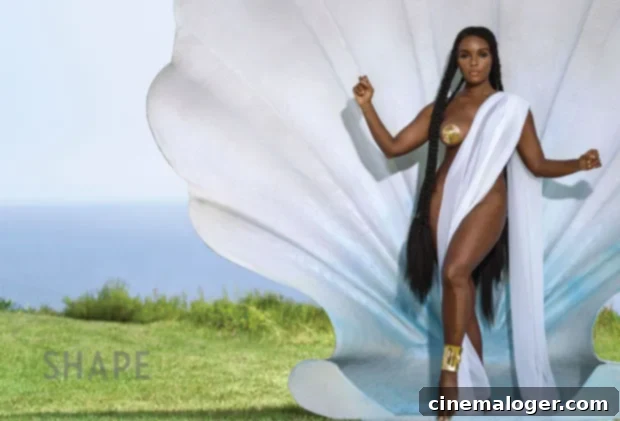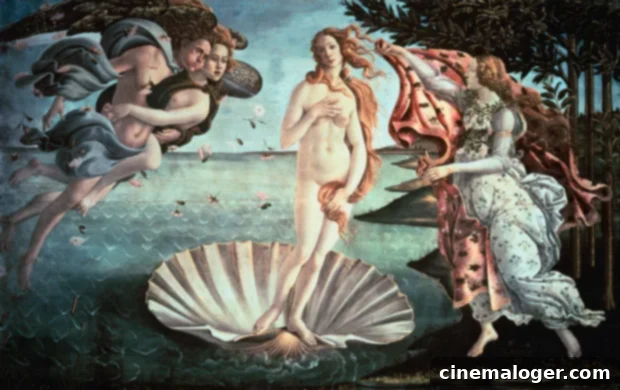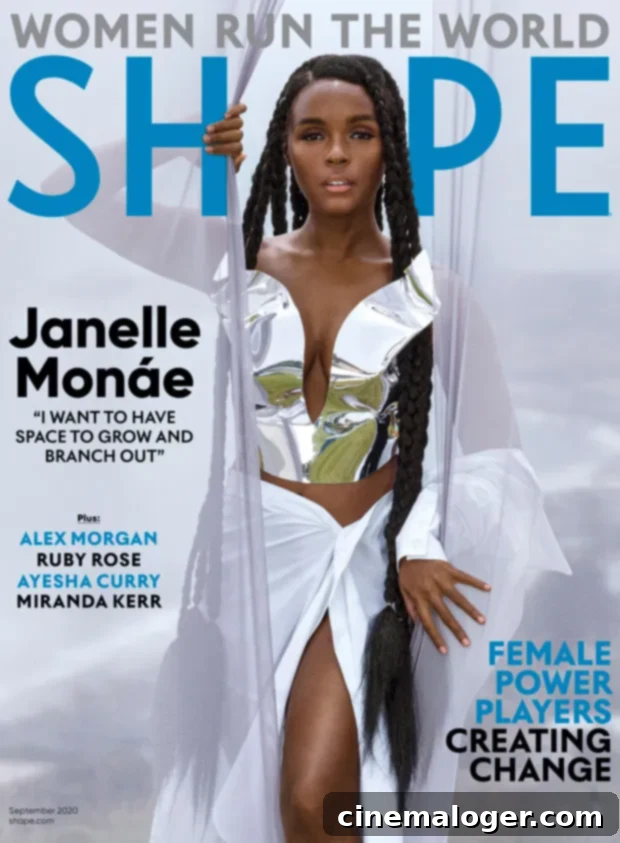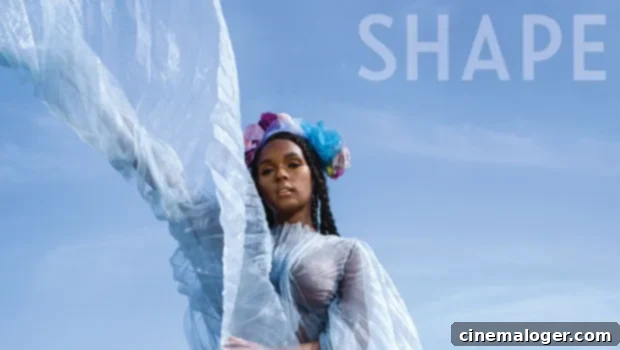Janelle Monáe’s Ethereal Transformation: Botticelli’s Venus Reimagined for Shape Magazine, Igniting Conversations on Art and Activism
Wherever she goes, whatever stage she commands, Janelle Monáe consistently captivates with her unparalleled artistry and commanding presence. The acclaimed actress and Grammy-nominated singer, known for her powerful roles in films like Moonlight and Hidden Figures, once again demonstrated her remarkable ability to blend art, fashion, and social commentary on the cover of Shape Magazine’s September issue. Beyond her consistently stunning appearance, Monáe delivered a visual masterpiece, recreating one of art history’s most iconic images: Sandro Botticelli’s 15th-century Renaissance painting, ‘The Birth of Venus’.
This striking editorial choice was more than just a beautiful photo; it was a deliberate artistic statement, perfectly aligning with Monáe’s persona as a multifaceted artist and unapologetic activist. The feature not only showcased her incredible physical and artistic versatility but also provided a platform for her to candidly discuss her vital activism work and her highly anticipated psychological horror film, Antebellum. Janelle Monáe’s ability to seamlessly traverse the worlds of music, film, fashion, and social justice cements her status as a true cultural icon, consistently challenging norms and inspiring change.
A Modern Goddess Emerges: Janelle Monáe Recreates ‘The Birth of Venus’
Among the breathtaking array of photographs captured for Shape Magazine, one image immediately stood out, resonating deeply with art enthusiasts and Monáe’s fans alike. This particular selection saw her transform into a modern-day Venus, meticulously recreating the iconic pose from Sandro Botticelli’s revered masterpiece. The visual parallel was undeniable, yet distinctly Janelle, imbued with her unique essence and contemporary relevance.

In the image, expertly captured by photographer Dana Scruggs, Janelle Monáe embodied a true goddess-like aura. Her form was gracefully and thoughtfully draped with a luxurious white fabric, evoking the classical modesty of Venus while simultaneously exuding strength and confidence. Her long, elegant tresses cascaded past her shoulders, adding to the ethereal quality of the portrait. Parts of her body were adorned with carefully chosen gold props and accessories, catching the light and emphasizing her statuesque presence. She stood stoically, her gaze powerful and serene, positioned in front of a magnificent, oversized scallop shell – a direct and unmistakable reference to Botticelli’s original work. The sheer artistry and attention to detail in this recreation were astounding, demonstrating a profound respect for the historical masterpiece while infusing it with Monáe’s signature contemporary flair.
A Striking Visual Dialogue: Janelle Monáe’s Interpretation of an Enduring Classic
The decision to recreate ‘The Birth of Venus’ is particularly poignant, given the original painting’s status as a symbol of beauty, rebirth, and the arrival of a new era. For Janelle Monáe, an artist who constantly pushes boundaries and redefines perceptions of beauty and identity, this choice speaks volumes. Her rendition is not merely an imitation but a powerful reimagining, inviting viewers to consider the painting’s themes through a modern, inclusive lens. It’s a testament to her vision that she can inhabit such an iconic role with both reverence and innovation, making the classic feel fresh and relevant for today’s audience. This photograph transcends a simple magazine spread, elevating itself to a piece of performance art in its own right, showcasing Monáe’s deep understanding of visual storytelling and her ability to evoke profound emotions through her presence.
Unpacking Botticelli’s Masterpiece: The Original ‘Birth of Venus’
To fully appreciate the significance of Janelle Monáe’s recreation, it’s essential to understand the grandeur and context of Sandro Botticelli’s original ‘The Birth of Venus’. Dating back to the 1480s, this iconic tempera painting on canvas is one of the most celebrated works of the Italian Renaissance and is housed in the Uffizi Gallery in Florence, Italy. It depicts the goddess Venus arriving at the shore after her birth, emerging from the sea already a fully grown woman. The painting is a magnificent celebration of beauty, love, and fertility, and is widely considered an early example of large-scale canvas painting in Renaissance Italy, pushing the boundaries of artistic expression at the time.

The celebrated and often recreated painting features the goddess Venus standing in a majestic scallop shell on water, an image that has become synonymous with classical beauty. She is flanked by the god of wind, Zephyr, who often appears with his wife Aura, carrying roses as they blow her ashore, and a woman, noted by art historians as Horae (or one of the Hours), who is elegantly dressed in a long, flowing garment, preparing to clothe Venus with a floral cloak as she steps onto land. The composition, vibrant colors, and graceful figures exemplify the Renaissance ideal of humanism and classical revival. This revered work of art captures the profound moment of Venus’s arrival to the shore after her mythical birth, embodying ideals of perfection and divine beauty. Janelle Monáe and Shape’s stunning recreation thus puts a beautiful, contemporary twist on this enduring painting, subtly challenging traditional representations while speaking completely to Janelle’s own unique artistry—an artistry she has cultivated and cherished since her earliest days.
Artistry Beyond the Canvas: Janelle Monáe’s Creative Journey
The depth of Janelle Monáe’s artistic expression, whether through a visual recreation or her extensive body of work, stems from a profound connection to her own creative spirit. Her journey is one of self-discovery and relentless development, a theme she eloquently shared with Shape Magazine. “Early on, I realized that I had something to write,” Janelle shared with the outlet. “I had my own musical instead of trying to be in musical theater or on Broadway. There was an artist in me that was looking to be developed. And only I could develop that artist.” This sentiment encapsulates the essence of Monáe’s career: an unwavering commitment to crafting her unique narrative and aesthetic, rather than conforming to preconceived notions.

Over the course of her impressive career, the multi-Grammy-nominated singer has seamlessly transitioned from a groundbreaking musician to a celebrated film actress, often managing to excel in both fields simultaneously. Her music is characterized by its genre-bending fusion of R&B, funk, soul, and sci-fi elements, often exploring themes of identity, futurism, and liberation. Similarly, her film roles consistently challenge the status quo, portraying complex characters and contributing to narratives that spark important conversations. But while her work as an entertainer has always been vital to her purpose in life and a means of profound self-expression, she has increasingly found that her efforts in activism offer her an equally profound sense of fulfillment and purpose. For Monáe, art and advocacy are not disparate paths but deeply interconnected facets of her identity, each amplifying the other to create a powerful and resonant voice for change.
A Voice for Change: Janelle Monáe’s Powerful Activism
Beyond the glamour of magazine covers and the allure of Hollywood, Janelle Monáe remains deeply committed to social justice, especially for the Black community and other marginalized groups. Her activism is not a separate endeavor but an intrinsic part of her identity, influencing her art and public discourse. “Being Black, especially during this time, for me, is heavy,” Janelle confessed in her interview, articulating a sentiment shared by countless individuals during periods of heightened racial injustice and unrest. “It’s traumatic, and all I want to do is figure out how I can be of help to my community.” This candid admission underscores the genuine burden she feels and her proactive approach to alleviating it, transforming personal pain into collective action.
For her part, Janelle has been actively fostering dialogue and understanding through her company, Wondaland Arts Society. She has been hosting impactful Zoom meetings, creating safe and inclusive spaces for critical conversations. These gatherings invite a wide array of perspectives, bringing together “white folks, Asian folks, Black folks, straight, gay—like a full spectrum of people and perspectives.” Her aim is to facilitate constructive dialogue that bridges divides, educates, and empowers, recognizing that true change requires collective effort and mutual understanding. Monáe’s commitment to using her platform for education and advocacy highlights her role as not just an entertainer, but a dedicated social architect, building bridges towards a more equitable future. Her activism is a consistent thread throughout her career, reinforcing her belief in the power of community and the necessity of confronting difficult truths head-on.
Confronting Discomfort: The Impact of Janelle Monáe’s Film “Antebellum”
As if her musical career and activism weren’t demanding enough, Janelle Monáe continues to expand her artistic repertoire through impactful cinematic ventures. Her highly anticipated psychological horror film, Antebellum, was slated for release in the wake of her Shape cover, adding another layer to her multifaceted public persona. The film follows a successful author, portrayed by Janelle herself, who finds herself inexplicably trapped in a horrifying time warp, thrust into the brutal realities of Antebellum America. The premise alone is designed to provoke thought and discomfort, mirroring the very conversations Monáe champions in her activism.
Speaking about her involvement in such a challenging project, Janelle articulated the film’s crucial relevance: “I think discomfort is part of everyone’s reality right now. White people are feeling discomfort in one way, Black people are feeling discomfort in one way, and I didn’t want to shy away from that.” This statement powerfully frames the film not just as entertainment, but as a catalyst for much-needed societal introspection. She continued, “It’s time for us to get uncomfortable, because real change requires an upsetting and a rerouting and a real commitment to look at ourselves.” Monáe’s willingness to embrace and even champion discomfort speaks to her profound understanding that genuine progress often emerges from challenging established norms and confronting uncomfortable truths about history and systemic oppression.
The film serves as a stark reminder of the enduring legacy of slavery and racial injustice, pushing viewers to acknowledge the ways in which historical oppression continues to manifest in contemporary society. By immersing audiences in such a visceral experience, Antebellum aims to provoke a deeper examination of systemic issues. In this instance, Janelle expressed a specific hope: “I hope that more white people see this film and fix the systems that their ancestors created that continue to oppress.” This powerful call to action transforms the cinematic experience into a direct plea for accountability and structural change, underscoring Janelle Monáe’s unwavering dedication to justice and her belief in the transformative power of art.
Janelle Monáe: An Icon of Art, Advocacy, and Authenticity
Janelle Monáe’s appearance on the cover of Shape Magazine, highlighted by her stunning recreation of Botticelli’s ‘The Birth of Venus’, is far more than a visual spectacle. It serves as a potent microcosm of her entire career: a brilliant fusion of artistic innovation, profound authenticity, and unwavering commitment to social change. From her early determination to develop her unique artistic voice to her seamless transitions between music and film, Monáe has consistently demonstrated a fearless approach to creativity.
Her powerful statements on the complexities of being Black in America and her proactive efforts to foster meaningful dialogue through her Wondaland Arts Society embody her role as a vital advocate. Furthermore, her willingness to engage with challenging narratives through films like Antebellum showcases her understanding of art as a tool for critical reflection and systemic critique. Janelle Monáe stands as a beacon for those who believe in the power of art to inspire, provoke, and ultimately, drive societal evolution. She is not merely an entertainer but a visionary, an activist, and an enduring symbol of individuality and empowerment in the modern era.
